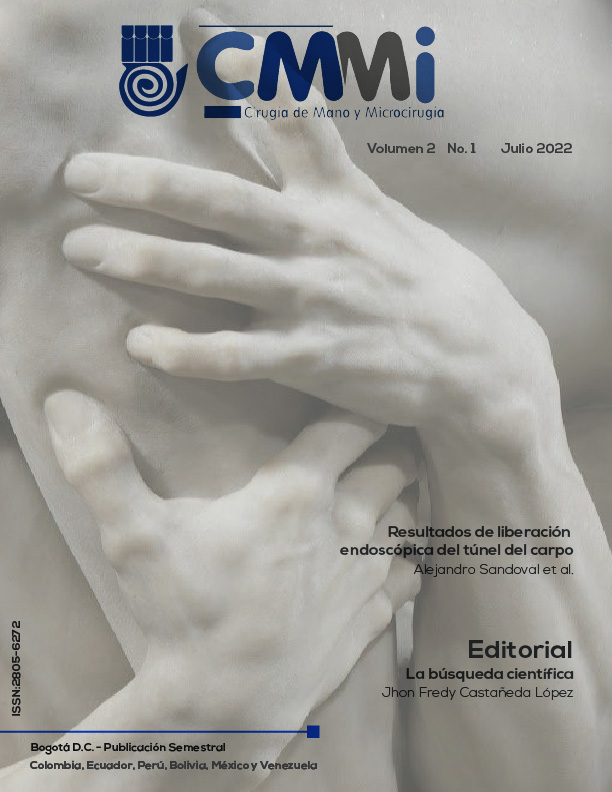Phalanx transfer to make a two phalanges finger
DOI:
https://doi.org/10.25214/28056272.1489Keywords:
Hand Injuries, Bone Transplantation, ArthrodesisAbstract
The hands are especially vulnerable to traumatic injuries, the fingers being the most frequently injured area, especially in the workplace, which entails serious complications for both the patient and the health system. Several techniques have been postulated in the management of severe injuries to the fingers.
These techniques have the objective of maintaining length and functionality; Under these principles, the best alternatives are sought to achieve that; Thus, the pedicled transfer of the distal phalanx to the middle phalanx position is proposed to make a two phalanges finger.
We present the authors’ clinical and surgical experience with the use of this technique for the management of severe injuries on the middle phalanx of the digits with the objective of maintaining the greatest amount of viable tissue and functionality of the hand. With the described technique, good functional and aesthetic results are observed in the short and medium term, and this option can be considered as a valid technique for the management of lesions at the level of the phalanges in which the distal end is still viable.
Downloads
References
Duncan SF, Saracevic CE, Kakinoki R. Biomechanics of the Hand. Hand Clin 2013;29(4):483-92. DOI: 10.1016/j.hcl.2013.08.003.
Foo A, Sebastin SJ. Secondary interventions for mutilating hand injuries. Hand Clin 2016;32(4):555-67. DOI: 10.1016/j.hcl.2016.07.006.
Li X, Cui J, Maharjan S, Yu X, Lu L, Gong X. Neo-digit functional reconstruction of mutilating hand injury using transplantation of multiple composite tissue flaps. Medicine 2016;95(27):e4179. DOI: 10.1097/md.0000000000004179.
Nusselt T, Hofmann A, Wachtlin D, Gorbulev S, Rommens PM. CERAMENT treatment of fracture defects (CERTiFy): protocol for a prospective, multicenter, randomized study investigating the use of CERAMENT™ BONE VOID FILLER in tibial plateau fractures. Trials. 2014;15(1):75. DOI: 10.1186/1745-6215-15-75.
Bhatt RA, Rozental TD. Bone graft substitutes. Hand Clin. 2012;28(4):457-68. DOI: 10.1016/j.hcl.2012.08.001.
Ruta D, Ozer K. Open fractures of the hand with soft tissue loss. Hand Clin. 2013;29(4):551-67. DOI: 10.1016/j.hcl.2013.08.008.
Kokkoli E, Spyropoulou GA, Shih HS, Feng GM, Jeng SF. Heterotopic procedures in mutilating hand injuries: A Synopsis of Essential Reconstructive Tools. Plast Reconstr Surg. 2015;136(5):1015-26. DOI: 10.1097/prs.0000000000001721.
McLeod GJ, Peters BR, Nguyen CM, Petropolis CJ. Vascularized pedicled proximal phalanx flap for spare part for reconstruction of metacarpal avulsion injury. Plast Reconstr Surg Glob Open. 2019;7(11):e2570. DOI: 10.1097/gox.0000000000002570.
Myeroff C, Archdeacon M. Autogenous bone graft: donor sites and techniques. J Bone Joint Surg Am. 2011;93(23):2227-36. DOI: 10.2106/jbjs.j.01513.
Kavin M, Liss FE. Identifying and treating traumatic hand and wrist injuries. JAAPA. 2018;31(7):16-21. DOI: 10.1097/01.jaa.0000534975.38742.c4.
Evans D, Gikas PD, Hanna S, Jagiello J, Aston W, Briggs TWR. The use of free, mainly cancellous bone grafts for reconstruction of phalanges and metacarpal bones following tumour resection. Eur J Plast Surg. 2008;31(5):229-34. DOI: 10.1007/s00238-008-0274-7.
Liodaki E, Kraemer R, Mailaender P, Stang F. The use of bone graft substitute in hand surgery. Medicine (Baltimore). 2016;95(24):e3631. DOI: 10.1097/md.0000000000003631
Downloads
Published
How to Cite
Issue
Section
License
Copyright (c) 2022 Cirugía de Mano y Microcirugía

This work is licensed under a Creative Commons Attribution 4.0 International License.
| Article metrics | |
|---|---|
| Abstract views | |
| Galley vies | |
| PDF Views | |
| HTML views | |
| Other views | |




